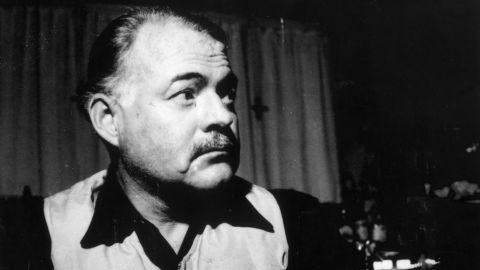Put Away That Cell Phone or Ernest Hemingway Will Punch You in the Face
By James Noll
Caveat emptor: This was supposed to be a light piece about “Ernest Hemingway: Substitute Teacher,” but I got sidetracked over the holidays binge-watching Yellowstone, a modern take on the kind of life Hemingway lionized, filled with guns and violence and gun violence, tough guys punching each other in the face, tough women punching tough guys in the face, cows, hunting, treeless prairies, and Our Hero, John Dutton, standing in the middle of it all, displaying grace under pressure and embodying the immortal words of big game hunter Robert Wilson in Hemingway’s African safari story “The Short Happy Life of Francis Macomber” as he quotes Shakespeare, “By my troth, I care not; a man can die but once; we owe God a death and let it go which way it will, he that dies this year is quit for the next.”
The Hemingway piece, had I gotten around to writing it, would have been a fish-out-of-water scenario. How would a guy like Hemingway, as ridiculous a proponent of virile manliness as they come, deal with today’s academically undisciplined, technology-addled high school children?
I envisioned Hemingway trying to teach his students the merits of push-ups and guns, organizing fight clubs, taking them fishing and hunting. He’d teach them how to be real men (even the girls), and a few of them might actually enjoy it. He’d tackle SAT prep, kids who signed out hall passes to go to the restroom and never came back, administrators who frowned on him taking snorts from his flask during class. Eventually a kid would mouth off to him, and Hemingway would punch the kid in the face.
But it was a one-note storyline and I got bored with it. (I got bored with the concussive machismo of Yellowstone, too, though that didn’t stop me from sitting through the first four seasons over the course of Christmas.)There were only so many times I could show Hemingway failing to reach today’s schoolchildren, then getting angry and breaking somebody’s jaw. Plus, I didn’t think he could even begin to understand the youth of today. In his mind, they’d all be just a bunch of whiny loafers. What would be the point?
I don’t mean to turn this into a diatribe on “Kids these days.” It’s too easy a target. Kids these days are basically the same as they were when I was a kid in all but one way: their addiction to cell phones.
And THAT’S the thing I think Hemingway would have hated.
Not cell phones themselves, really. He would have loved posting pictures of his latest kill on Instagram or making self-promoting videos on the TikToks. But observing the clear hold cell phones have on people, especially people who were supposed to be paying attention to him, would have driven Hemingway nuts.
When I first started teaching, many veterans in the profession thought that students knew how to use computers well. The students did not know how to use computers well. The students did not know how to use computers very well at all. They could type up a paper in Word, but that was about it. They didn’t know how to create a table or format a document. They didn’t know how to use a spreadsheet (they still don’t). They couldn’t search a database or find legitimate sources online. They did know how to play Oregon Trail. While the pandemic has gone a long way in rectifying this situation, these days I’d say most students are more adept at pushing reaction buttons, taking pictures or video, or scrolling than they are using technology in any kind of productive manner.
I’ve witnessed the evolution of cell phone addiction, from the flip phone, through the early smartphone, to the current high-powered pocket computers, and throughout every iteration, the negative effect they have upon my students has advanced accordingly.
The biggest disruption cell phones created in class during the flip phone era was the occasional ringtone blasting out of a kid’s pocket as mom or dad tried to call them in the middle of class. Texting cost too much then, and the numeric keypads were too clunky to use anyway, so the kids weren’t consumed by that yet. Early smart phones were a clear advancement. Still, mostly students used them to text, which at the time was the equivalent to writing notes to each other. Some of the students’ parents paid for enough data to stream video, but the phones didn’t handle the load very well. But like a frog sitting in a slowly boiling pot of water, the negative effects of cell phones crept up on us; now I catch kids watching Netflix or Disney+ or watching video game walkthroughs on YouTube all the time.
I first noticed the big change about two years before the pandemic. Prior to the ubiquity of smartphones, the final five to ten minutes of class was marked by chaos. Students packing up their backpacks, talking, yelling, laughing. It used to bother me. High School boys, in particular, are loud and obnoxious. However, around 2017, the exact opposite began to happen. Instead of gathering by the door and jostling for pole position, they sat at their desks, staring at their devices. It was even eerier in the morning during homeroom. They gazed at their phones for the full 20 minutes, the room utterly silent, then stood as one when the bell rang for first block and wordlessly shuffled out of the room.
I’d like to say I enjoyed the silence, but I didn’t. The image of 30 sets of eyes staring blankly at screens, robotic and expressionless as they tapped and scrolled away was worse than anything Huxley or Orwell could have ever imagined. George Romero, however, nailed it in Night of the Living Dead. This continued through 2019, although up until that point, it was much easier to get students to put their devices away during instruction. Generally, the kids and their parents respected the no-cellphone rule, and if a teacher confiscated one, few complained.
Post-pandemic, however, neither students nor their parents respect it at all. The cell phone is an appendage. They plug into the Internet in the same way they own fingers and toes, and woe betide any adult–even an Ernest Hemingway–who dares tell them to stop. I bet most administrators would be shocked to see how bad it is. Actually, I know this for a fact. In my prior county, due to staffing shortages, someone I know from central office has had to fill in for several teachers over the course of the past two years, and, well, she was shocked at the cell phone use.
“Oh, my gosh,” she said. “It’s really bad, isn’t it?”
I offered her my flask.
Here’s the rub: I don’t really think it’s the kids’ fault. There is plenty of research out there that explains cell phone addiction. The dings and notifications release dopamine, and people are helpless before the onslaught of the millions of micro-doses they receive every day.
But for obvious reasons, that still doesn’t mean we should allow them in school.
A recent article in Forbes discussed the French government’s ban on cell phone use in schools. The ban was implemented in 2018 for students from preschool (école maternelle) through ninth grade (collège). During the final three years of school (lycée), each building can create their own rules. According to Forbes, students have adjusted just fine. They turn off their phones and get to work. The results are predictable: French students are doing better on their exams.
In America, however, parents have swung in the opposite direction. They want access to their kids at any moment. The reasoning is twisted, if understandable.
I thought that the nadir of American gun violence had been reached with Sandy Hook. But then came Stoneman and Uvalde, and then a few days before I started writing this article, the nation’s sick obsession with guns reached a higher degree of absurdity and awfulness. A six-year-old in Newport News shot his teacher in the middle of class for no discernible reason. Not that anything, discernible or not, could possibly have made any sense.
That’s the principal reason American parents don’t want to ban cell phones in schools.
They know cell phones are a distraction. They know they negatively affect children’s ability to focus. They know this in turn negatively affects children’s education. But should a shooting occur in their child’s school–when a shooting occurs–American parents want to be able to say goodbye.
Maybe someday that will all change. Maybe someday there won’t be more guns than people in America. Maybe someday six year olds won’t find loaded handguns in their parents’ bedrooms and bring them to school so they can shoot their first-grade teachers, or their classmates, or themselves. Maybe someday there won’t be 51 school shootings resulting in injury or deaths as there were last year in the U.S. Maybe someday parents will decide that constant access to cell phones is no longer necessary to ensure a child can make that one last call before the shooting begins in their classroom.
“Yes,” as Hemingway wrote at the end of The Sun Also Rises, “isn’t it pretty to think so?”
***
James Noll has worked as a sandwich maker, a yogurt dispenser, a day care provider, a video store clerk, a day care provider (again), a summer camp counselor, a waiter, a prep cook, a sandwich maker (again), a line cook, a security guard, a line cook (again), a bartender, a librarian, and a teacher. Somewhere in there he played drums in punk rock bands, recorded several albums, and wrote dozens of short stories and a handful of horror, sci-fi, and post-apocalyptic novels, including Raleigh’s Prep, Tracker’s Travail, Topher’s Ton, The Hive, The Rabbit, The Jaguar & The Snake, and Mungwort. You can check him out online at silverhammer.studio.


